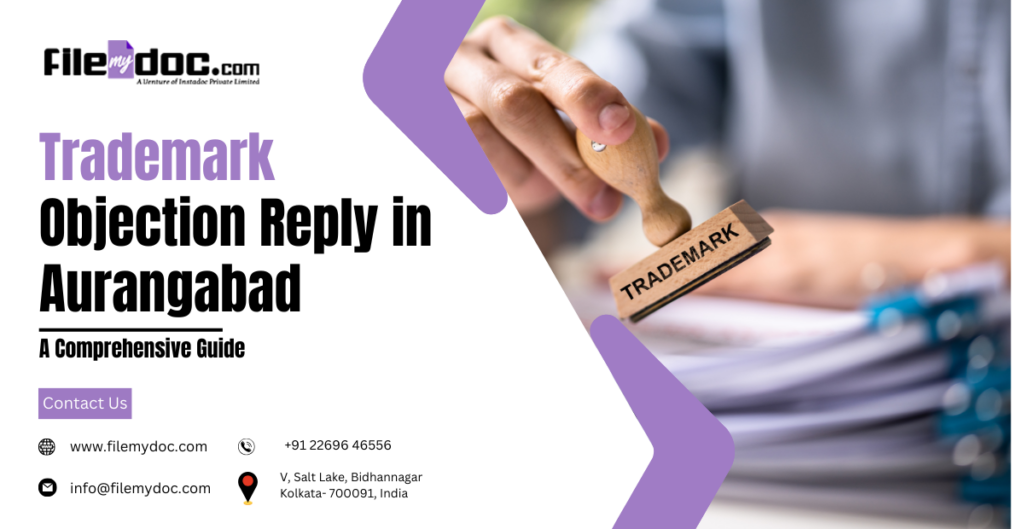Trademark Objection Reply in Aurangabad : A Comprehensive Guide
Introduction
Starting a business involves many steps, and one of the most crucial is securing your brand identity through a trademark. A trademark protects your brand’s name, logo, and other identifiers from being used by others. However, the process isn’t always straightforward. One common hurdle is receiving a trademark objection. In this article, we will delve into the intricacies of drafting a Trademark Objection Reply in Aurangabad.




Understanding Trademark Objection
Definition of Trademark Objection
A trademark objection occurs when the trademark examiner raises concerns regarding your trademark application. This doesn’t mean your application is rejected, but it requires you to address the issues raised.
Common Reasons for Trademark Objection
- Similarity to Existing Trademarks: If your proposed trademark is too similar to an existing one, it might confuse consumers.
- Descriptive Nature: Trademarks that describe the goods or services might face objections.
- Prohibited Marks: Certain symbols and terms are not allowed under trademark law.
Trademark Objection Reply
Importance of a Trademark Objection Reply
Responding to a trademark objection promptly and effectively is crucial. A well-crafted reply can overcome the objections and move your application forward.
Steps to Draft an Effective Trademark Objection Reply
- Read the Objection Carefully: Understand the grounds for the objection.
- Gather Evidence: Collect documents and arguments to support your case.
- Draft a Clear and Concise Reply: Address each objection point systematically.
- Submit Within Deadline: Ensure your reply is submitted on time.
How to Respond to a Trademark Objection in Aurangabad
Legal Framework in Aurangabad
Aurangabad, being a significant commercial hub in Maharashtra, follows the Indian trademark laws governed by the Trademarks Act, 1999. Understanding this framework is essential for a successful reply.
Preparing Your Response
- Consult Legal Professionals: Consider seeking advice from trademark attorneys familiar with local laws.
- Customize Your Reply: Tailor your response to address specific objections cited by the examiner.
- Documentation: Include all necessary documents, such as affidavits, evidence of use, and other relevant materials.
Components of a Strong Trademark Objection Reply
Addressing the Objection Grounds
Each objection should be tackled with clear arguments. For example, if the objection is due to similarity with another trademark, demonstrate how your trademark is distinct.
Providing Evidence and Arguments
- Usage Evidence: Show how your trademark has been used in commerce.
- Market Research: Provide data to support the uniqueness of your trademark.
- Legal References: Cite relevant case laws and precedents.
Legal Precedents and References
Including references to previous successful cases can strengthen your reply. Demonstrating how similar objections were overcome in the past can be persuasive.
Common Mistakes to Avoid
Ignoring the Objection
Not responding to the objection will likely result in the rejection of your application.
Inadequate Evidence
Ensure you provide sufficient evidence to support your arguments.
Missing Deadlines
Adhere strictly to the deadlines to avoid complications.
Hiring a Professional vs. DIY Reply
Benefits of Hiring a Professional
- Expertise: Professionals have the experience and knowledge to handle complex objections.
- Time-Saving: They can expedite the process, saving you time and effort.
Steps for a DIY Reply
- Research: Invest time in understanding the objection and how to address it.
- Drafting: Follow guidelines and templates to draft a comprehensive reply.
- Review: Have a legal expert review your reply before submission.
Trademark Objection Reply Template
Sample Template
- Introduction: Briefly state the purpose of the reply.
- Response to Objection: Address each objection point with arguments and evidence.
- Conclusion: Summarize your position and request for acceptance.
Customizing the Template for Your Needs
Adapt the sample template to fit the specifics of your case, ensuring all objections are thoroughly addressed.
Post-Reply Process
What to Expect After Submission
After submitting your reply, the trademark examiner will review your response. This can result in:
- Acceptance: Your trademark application proceeds to the next stage.
- Further Examination: Additional objections or queries may be raised.
- Rejection: If objections are not satisfactorily addressed.
Possible Outcomes and Next Steps
If your reply is successful, your trademark will be published in the Trademark Journal. If not, you may need to appeal or consider other legal options.
Maintaining Your Trademark
Regular Monitoring and Maintenance
Ensure you monitor your trademark for any potential infringements and take action when necessary.
Renewals and Updates
Trademarks need to be renewed periodically. Keep track of renewal dates and update your trademark details as required.
Conclusion
Navigating the trademark objection process can be challenging, but with the right approach and timely action, it’s manageable. Whether you choose to handle it yourself or hire a professional, understanding the process and preparing a strong reply are key to overcoming objections and securing your trademark in Aurangabad.
FAQs
Q.1 What is a trademark objection?
A trademark objection is a formal issue raised by the trademark examiner questioning the registrability of your trademark.
Q.2 How long do I have to respond to a trademark objection?
Typically, you have 30 days from the date of receipt to respond to a trademark objection.
Q.3 Can I respond to a trademark objection myself?
Yes, you can respond to a trademark objection yourself, but it’s often advisable to seek professional help to ensure a strong reply.
Q.4 What happens if I miss the deadline to respond to a trademark objection?
Missing the deadline can result in the abandonment of your trademark application.
Q.5 How can I prevent trademark objections in the future?
Conduct thorough searches before filing, ensure your trademark is unique, and comply with all legal requirements to minimize the risk of objections.



























